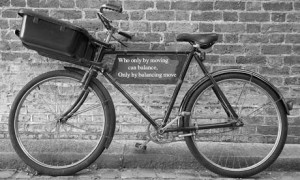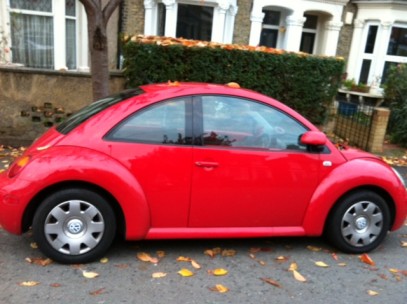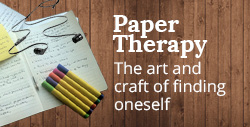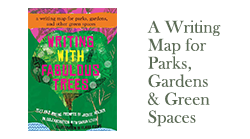Writing
Thursday, December 6th, 2012
 Today I didn’t feel like going for my early morning walk. It had just gone 6am, the house was slowly warming up and outside looked dank and dark. I didn’t want to leave the cosiness of my home to face the frost and the cold of the early morning to walk for an hour.
Today I didn’t feel like going for my early morning walk. It had just gone 6am, the house was slowly warming up and outside looked dank and dark. I didn’t want to leave the cosiness of my home to face the frost and the cold of the early morning to walk for an hour.
Despite my feelings I did it anyway. Barely five minutes into my walk I found myself totally absorbed. I was loving the fresh, crisp air, enjoying taking the deep breathes and having fun exhaling streams of mist into the cold air.
During my walk my mind wandered to my morning’s dilemma of not wanting to walk and I realized how close a connection this feeling has to how many times I find myself not wanting to feeling in the mood to write.
There are many occasions when I find myself feeling this way and indeed many moments when I don’t always feel confident about my ability to write. I’ll have a crisis of confidence about what I want to say, compare my writing and doubt my credibility.
But always I find there is only one way to fix this seeping fear and that is to, simply and graciously take action. What works best for me are small actions which build momentum.
The truth of the matter is you don’t have to feel ready, confident or even prepared but the very act of taking action will always move you forward and further than if you did nothing at all.
You’ll find that some of the most successful writers are not necessarily the most talented. There are many talented writers sitting in homes just like yours. The difference is that the first act and the second group don’t. The first keep going and the second group give up at some point along the way.
Taking action does not require you to write perfectly. It’s not a guarantee that all that you write will be of value (the likelihood is that most of it won’t be of use). And sometimes you’re left feeling that what you write is crap. But keeping the pen moving over the page on a regular basis is what makes you a writer rather than someone who wants to write.
You don’t need to be the most confident person to succeed. In fact many successful people lack confidence in many areas but they have mastered the skill of taking action. Repetitive action leads to practice and practice turns into a habit and a habit practiced regularly over a considerable amount of time say 10,000 hours becomes mastery. I hope you get my point.
No Comments
Friday, November 30th, 2012

Friday’s poetry prescription is more of a musing. A lovely example of how one creative writing tutor generated the writing flow with one of of his writing participants by using something physical as a writing prompt.
“Once when I was working in a creativity worship in Iowa, an older woman wanted desperately to write poetry about her youth in rural corn country.
I asked her what she used to do that she would like to write about. Among her answers was “husking corn”.
I told her to wait and I dashed out and bought a half dozen ears of corn in a supermarket.
When I returned I had her sit as she used to and encouraged her to visualize the setting. With her eyes closed and sitting as she remembered I had her husk corn.
In less than ten minutes she produced her first poem.
Within an hour she had written nearly a dozen”.
Bob Samples
http://judithpordon.tripod.com/poetry/how_to_write_quotes.html
No Comments
Thursday, November 29th, 2012

For the last two days I’ve travelled four hours each day between London and Manchester on a Virgin train. I’m least distracted when I write on a train or a plane. I’ve worked out the reason for this, both are spaces where I experience least distractions. At home a thousand things can easily pull me away from the page, there’s a book to go find, a quote to go searching for or should I clean the bathroom, load the dishwasher, do my emails or paint my nails? But when I’m on a plane or a train these distractions are minimized. If I’m lucky to get a seat in a quiet coach on a Virgin train I’ll have very little noise to distract me from my writing.
On planes with the minimum scenery out the window and few spaces to walk around in I’m stuck usually for several hours in my seat. And bums on a seat is an essential requirement for the serious writer. Perhaps that why so many writers including Maya Angelou write in rooms without a view. They’ve cottoned on to the no distraction rule. Now I’m not suggesting that this is how I want to write all the time but it really does help for those times when focus and concentrating on what’s in front of me is just what is needed.
1. Where are the spaces you are least distracted?
2. What kind of writing is best to do in this space? First drafts, editing, playing with ideas?
3. Plan to write in those spaces as often as you can but also locate the quiet spots in your neighbourhood.
4. Or if all else fails buy a pair of sound deafening ear headphones.
No Comments
Monday, November 26th, 2012

What’s in the trunk? In fact what on earth is this strange looking item? I took this photograph of what we call the trunk from my parents home on the Caribbean island of Barbados. The trunk was a very familiar item to many African Caribbean families in the 60′ and 70′s. Our parents would tell us stories of the items stored in the trunk which either accompanied them on their sea voyage from the West Indies or became a permanent feature in their family homes in the UK.
Today’s Visual Writing prompt invites you to write about what may have been stored in the trunk by someone travelling from the Caribbean in the 1960′s? If you were to open it what would you find?
Free write for 15 minutes.
No Comments
Friday, November 23rd, 2012

The Yellow Tulip
For weeks
it struggled
through the hard crust
of the spring earth
and a foot
of air
Just to be
scorched
by the sun
jolted
by raindrops
blasted
by the wind
But on this gentle
May morning
as it opens
yellow petals
to the sky
Nothing else matters
George Swede (1940 – Canadian psychologist, poet and children’s writer)
Poetic Inquiry
1. What lines speak to you from the poem?
2. Write about a time in your life or career where you were the Yellow Tulip.
3. What have you opened to recently in your life or career?
4. Take any line from the poem and use as a writing prompt for your writing practice
No Comments
Friday, November 23rd, 2012
 Photograph WinningWords www.winningwordspoetry.com
Photograph WinningWords www.winningwordspoetry.com
Every Friday to kick start your weekend we’ll post a poem on one or all three of the blogs.
There’s a poem for every ailment. We can write our own poems to distill our experiences or feelings or we can use the medicine and wisdom from other people’s poems to understand ourselves, and our worlds better. In the poetry world this technique is known as a poetry prescription. When I read other people’s poems they help me to better articulate and feel my emotions. I find myself in a relationship with the poet and a realization that I am not alone with what I experience on a day-to-day basis. Have you noticed how some poets find just the right words to describe particular events and life experiences from the large to the small?
More and more I’m noticing how poems stop me in my track. Causing me to pause and allow the words to sink in a more conscious and mindful manner. I like that about poetry. Reading poetry and engaging with a poem is an act of mindfulness, which brings health and emotional benefits to the reader.
Phyllis Klein and Perie Longo writing in an article, The Therapeutic Benefits of Poetry (2006) describes how a poem makes us feel safe because, “a poem has a border, a frame, or structure, as opposed to prose, the form itself is a safety net. Strong emotions will not run off the page.”
Lately I’ve been more courageous in writing poems of my own. When I do I am surprised by how accurately the poem both captures and mirrors my emotions and raw feelings.
Here at www.jackeeholder.com we’re experimenting with Poetic Inquiry. At the end of each poem you‘ll find a list of prompts should you wish to delve more deeply into the poem and explore its meaning and how the poem relates to you. When poetry therapists work with groups and individuals they’ll ask the group which lines resonate with them or what themes they’re drawn to. We hope the prompts offer you some of that exploration if you wish to reflect further. We’d love to know which poems speak to you or even post one of your poems as one of our Friday Poetry Prescription blogs.
No Comments
Thursday, November 22nd, 2012
On one of my recent walks to my local Sainsbury’s I decided to set myself a creative challenge of taking photos of as many trees with red leaves. This quickly turned into a photo assignment of snapping almost any object I passed with the colour red. Within 30 minutes I had at least five juicy images on my camera phone that I quickly turned into visual writing prompts.
Visual Writing Prompts are great to use when you need to warm up on the page before you get into your actual writing. Use them to fire up your creative and professional work. Getting into your imagination and accessing your theta thinking state can be useful stimulation for both creative and professional writing projects. You can do the same to create story lines for your characters for novels and short stories. Observe the visual image, ask a question related to your character and get writing. I’ve shared some ideas of how to turn an image into a prompt underneath each of the images I collected on my walks. And of course please feel free to make up your own.
I’ll share new visual writing prompts over the next few weeks.

Write a description of the person who rides this scooter
If you were loaned this scooter for a week and it could take you anywhere, where would you ride it to?
Put one of your characters from your novel or short story on this scooter and take them on a journey.

Write about the last telephone call you made from a Red Telephone kiosk?
Tell the story of a telephone call you will never forget?
Describe in as much detail as you can the person who last made a call from this box? How old were they? Who did they call? How much money did they place in the pay phone? What was the last sentence uttered before they said, ‘goodbye’?
Write about why this telephone box has been left standing in this location

Write about someone who lives here?
How is their personality or characteristics like or unlike the colour of the door?
Who chose the colour for this door and what was the reason for their choice.
Write about an entrance.

Write a poem or a short children’s story entitled the Red Beetle
Use the car as a narrator of a short story or poem
Put one of the characters in your novel behind the driving wheel and have them talk from this place

Hope and Greenwood is a sweetshop in East Dulwich where I live selling sweets from the 1960’s and 1970’s era
Write a personal essay or poem told through the memory of the sweets you enjoyed as a child growing up.
Write a story to accompany the scene in the shop window
Imagine this was 1965. Write a scene describing the people inside the shop on any given day in 1965.
No Comments
Wednesday, November 21st, 2012

Last year on my way to visit a friend ill in hospital I walked past the two statues in the above image. I was anxious about my visit but seeing the two statues caused me to stop and slow down. I was really taken in by so much of the installation that a few minutes went by without me even noticing how long I had stood there or the stream of people who passed me by. . In that moment I slowed right down and got lost in the moment. I became more present in my body and entered the hospital in a more relaxed and resourceful state to spend time with my friend.
I had a similar feeling last week on my way to a funeral. Walking along Dalston High Street in London at lunch time with busy traffic and pedestrians I glimpsed an artist at work across the street painting what looked like a watercolour. Again the scene caused me to stop and slow right down. He had leaned his easel up against a lamp post closest to the road side and despite the busy traffic roaring by he appeared fully immersed in his painting. I wanted to be him. I wanted to be the painting. He was what psychologist Mihaly Csikszentmihalyi describes as being in his flow. When was the last time you lost track of time and found yourself engrossed in an activity that was going against the speed of everyone else around you? It can be a challenge to be the odd one out. To go at a different speed than everyone else is moving at.
Sometimes when I’m travelling in early morning London rush hour traffic I notice that when I move at a slower speed to those around me people tend to barge past me or literally move me out of the way. It can be hard to find our own rhythm and speed when the rest of the world is going so fast. When was the last time you lost track of time because of your absorption in an activity? Slow is good. Fast doesn’t always mean better. How many people walked past those statues everyday and never give them a second thought? I hate to think how much we miss in our crusade for speed and getting there quick.
Really pausing and taking in these two images allowed me to connect with the strength and resilience I felt when observing the pieces. I was able to take those qualities with me when I finally entered the hospital to spend time with my friend.
You can use images around you as writing prompts and ideas for your creativity. that’s why I love having a camera on my phone so I can capture images and scenes and then store them for later inspiration. Taking out the image today has reminded me of my friend and how much strength she showed in the final months of her time with us. It was a strength made up of so many different qualities and elements. The image is a timely reminder, a visual signpost for me to begin to piece together some of the painful feelings I still feel around her death and her leaving us at what felt like so prematurely.
Todays image as a visual writing prompt t entice you onto the page. All you have to do is to free write for 10 minutes whatever thoughts or feelings come to you from exploring the image and responding to the following prompts? You don’t have to stick with the prompts. Just write what comes.
When you look at the image how does it make you feel?
What or who does it remind you of?
Who are the two people holding hands?
What story or memory does the image evoke?
No Comments
Wednesday, November 21st, 2012
No Comments
Tuesday, November 20th, 2012

Last week I found out that Susan Jeffers author of several self help books and the seminal bestseller Feel The Fear and Do It Anyway passed away. Reading the email caused me to pause in my day and reflect on the impact Susan had on my life. In real life we never met but we met at a poignant time in my life on the page. What she wrote and shared in her book Feel the fear and do it anyway had a significant impact on helping me get through a difficult place at the time. If you’re reading this blog page you could probably write your life story through a history of the books you’ve read at different times. Like music, books can remind us in an instant of where we were at certain moments on our life’s journey.
In my case I was 26 years old, heavily pregnant with my first and only child. I was browsing (do you remember a time when we used to browse in bookshops) in my local bookshop in Brixton when I came across her book. My favourite section has always been the self-help section and as soon as I saw the title ‘Feel The Fear And Do it Anyway’ I grabbed the last copy from the shelf. A quick skim read of the first few pages and I knew the book was going home with me. It was love at first sight.
Like new love I couldn’t wait and started eagerly reading on the bus home. That was back in 1988. The book is still in my collection. And finding it back in 1988 was just what I needed for where I was on my personal and professional journey. I know ‘Feel The Fear And Do it Anyway’ helped millions of people globally and the title became a mantra in the publishing world and the world of leadership and management.
I’ll leave you with this question on this rainy and dark Tuesday morning, “If you knew fear was a friend in disguise, what would you feel the fear and do anyway?
Susan will be missed.
Susan Jeffers
1938-2012
No Comments
 Today I didn’t feel like going for my early morning walk. It had just gone 6am, the house was slowly warming up and outside looked dank and dark. I didn’t want to leave the cosiness of my home to face the frost and the cold of the early morning to walk for an hour.
Today I didn’t feel like going for my early morning walk. It had just gone 6am, the house was slowly warming up and outside looked dank and dark. I didn’t want to leave the cosiness of my home to face the frost and the cold of the early morning to walk for an hour.
















